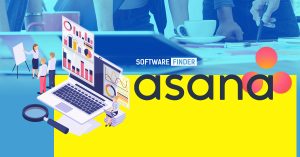
In this article, we will cover the features of Asana Software and explain the difference between a Task List and a Kanban board. We will also explore how tasks depend on each other and how reporting works. Asana is a good solution to managing work, but if you’re not sure how to use it, read this article for tips. It will be useful for you! Also, check out the Forrester Wave reports on the service.
Tasklist
The Asana Software task list can be a great way to keep track of your work. It can be used for many purposes, from managing your projects to organizing your life. You can create recurring tasks and mark them as complete. You can also automate your project management activities with this software. Asana has features that will help you create task templates for complex, multi-step tasks, and you can add subtasks and dependencies between tasks.
Teamwork is another benefit of Asana. It enables you to collaborate with others from anywhere. Its Timeline and Gantt-style views help you track all your team members’ status. You can set dependencies, see your team’s status, and track the progress of individual tasks. Asana also allows you to keep track of your teammates’ tasks, which makes collaboration with others easier than ever. Depending on the level of access you have, you can even manage your team’s privacy settings.
Kanban board
If you’re using Asana Software to manage your team’s project management efforts, you’ve probably already noticed the benefits of a Kanban board. Visualizing the project flow helps team members see how far each task has come. When multiple tasks are stuck in the same column, it is a sign that a bottleneck is forming, and you can allocate more resources to fix the problem. Moreover, the Asana Kanban Board allows you to set deadlines for each task, which makes it easier for team members to know where they’re falling behind.
The Kanban board helps project managers manage inefficiencies by setting a limit for the number of tasks in the “in-progress” column. This limit ensures that team members are working efficiently by preventing them from multi-tasking. Moreover, the limiting feature encourages team members to collaborate with one another and complete the tasks in a timely manner. The product of the Kanban board is delivered as and when needed, based on a defined due date.
Task dependency
Asana Software offers a feature that allows you to set up task dependencies between projects. By understanding the dependencies between tasks, you can plan your projects better and make necessary adjustments. Task dependencies can also be useful in situations where your project timeline is time-constrained. By knowing when a task is likely to be completed, you can estimate how long the project will take and adjust your timeline accordingly. There are two types of task dependencies: predecessor and successor.
When creating a new task in Asana, you can attach data and custom fields to it. These fields will include the priority of the task as well as the progress of the task. When you set a dependency between tasks, you can have task A start only after task B is completed. You can also add due dates for dependent tasks. This way, you can ensure that every task will be completed on time. And when you use Asana for your project, you can add tasks in the right order.
Reporting
For years, the Asana software hasn’t had a good reporting feature. But now, an ambitious developer has come up with an alternative – Asana2Go. This Chrome extension allows you to create customizable reports right from Asana, giving you a quick glance at the overall performance of your gig. The software is free and in beta. But we’ve got a couple of tips for reporting with Asana.
Although Asana is a relatively new project management software, it has a lot to offer. It is free and combines nicely with other software, including Gantt Charts. If you’re in a small business, Asana is ideal. Whether you have a big team or only a few people, you’ll find it handy. You can even use it to report on your team’s performance.
Security
Asana’s approach to security is foundational, starting with password hashing and least privilege access. The company is also vigilant about security by holding security-focused tea sessions and monitoring malicious activity. Its comprehensive security features include two-factor authentication, SAML 2.0, and robust data protection. Users can opt out of any of these features at any time. However, there are some key differences between the two. Asana collects minimal data from paid subscribers and more from free users.
The Asana platform is easy-to-use and flexible, making it suitable for teams of all sizes. Users can export data to text-based formats and view it on spreadsheets. Moreover, Asana also supports exporting data to other formats via its support ticket system or console. The software also supports TLS 1.1 and supports forward secrecy. It also blocks RC4 and TLS 1.0.

Asana Pricing – A Comparison Between Free and Paid Plans
There are two different types of Asana Pricing: free and paid. Free plans allow users to create projects without paying a cent, while paid plans require a monthly fee per member. Both free and paid plans give users multiple ways to track progress. Read on to learn more about each plan and its benefits. Alternatively, check out our Asana review for more details. Here we compare the two plans side by side and explain what they each offer.
Asana’s free plan
While Asana does offer a free plan, it is limited to fifteen team members per workspace or organization. This can prove to limit for some teams, but it is worth it to have unlimited team members if you’re working on several projects at once. The free plan also has other limitations, including the number of members that can access the workspace, so it’s a good idea to check out the paid plans before committing to a free plan.
Despite the limitations of the free plan, Asana’s basic plan is still one of the most attractive options available on the market. Free users can collaborate with up to 15 teammates, create unlimited projects, and keep track of tasks and messages. In addition, this plan also includes free time tracking tools. Free plans also let you customize the dashboards with your own design. They also provide a few features, but they’re basic and don’t let you get as advanced as premium plans.
Workspaces are designed for personal tasks, but they are also good for flexible projects. Users can add up to 15 members to workspaces, but if you’re working with a large team, you’d need more than 15 members. You can also add “limited access” members to your organization, usually clients that are participating in a project. However, they count towards the total number of seats. If you’re in a hurry, the free plan isn’t the best option.
Asana’s integrations with other programs
Asana’s integrations with other apps allow users to consolidate all their tasks and projects into one place. The syncing of your calendars can save you time and reduce stress by automatically updating the same app on your team’s schedule. Connecting your calendar to Asana is as easy as clicking “Connect to Asana.” You’ll need Asana credentials to connect with other apps. Once you’re connected, and integration column will be added to your board.
Asana’s built-in collaboration features encourage teamwork. For example, Teammate View allows team members to see what tasks are assigned to them. Similarly, Project Members can view information shared by the organization and with the rest of the team. Asana’s customizable dashboards make it easy to track various tasks, from customer inquiries to hiring new employees. Moreover, you can create a workspace for group conversations.
If you use Adobe Creative Cloud or Adobe CC, Asana is compatible with these applications. With this integration, creative teams can access information directly in Asana. They can create tasks, assign subtasks, and deliver assets. Asana’s integration with Campaign Monitor makes it possible to better monitor your subscribers with the help of these programs. For example, you can send notifications to your subscribers when new subscribers join, or when specific actions happen in a campaign.
Asana’s mobile app
Asana’s mobile app is available for iOS and Android devices. The program has several features for teams and projects, including an intuitive design and team collaboration tools. It allows you to share tasks, communicate with team members, and assign tasks to each other. Asana’s feature set includes attachments, such as PDFs, images, and spreadsheets. In addition, the app is social and has a “like” button for sharing projects on social networks.
Asana’s pricing options vary widely. The basic plan comes with free features. If you need more features, you can upgrade to the Enterprise plan. In addition to a free plan, Asana also offers priority support from a customer success manager. This is helpful if you have questions or need help with a project. If you have a small team and don’t need more features, you can always stick with the free plan.
Asana’s cloud-based collaboration and task management platform is designed for teams of any size. It is designed to streamline communication across teams, stay organized, and meet deadlines. It’s designed for teams of any size, from small teams to larger enterprises. Teams can use Asana to plan events, track paid marketing campaigns, and manage content calendars. However, Asana’s pricing policy can be confusing, especially since the company offers monthly and annual plans.




